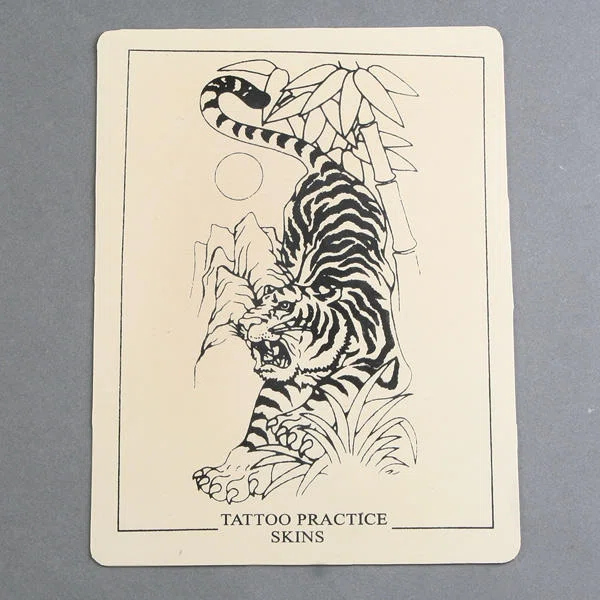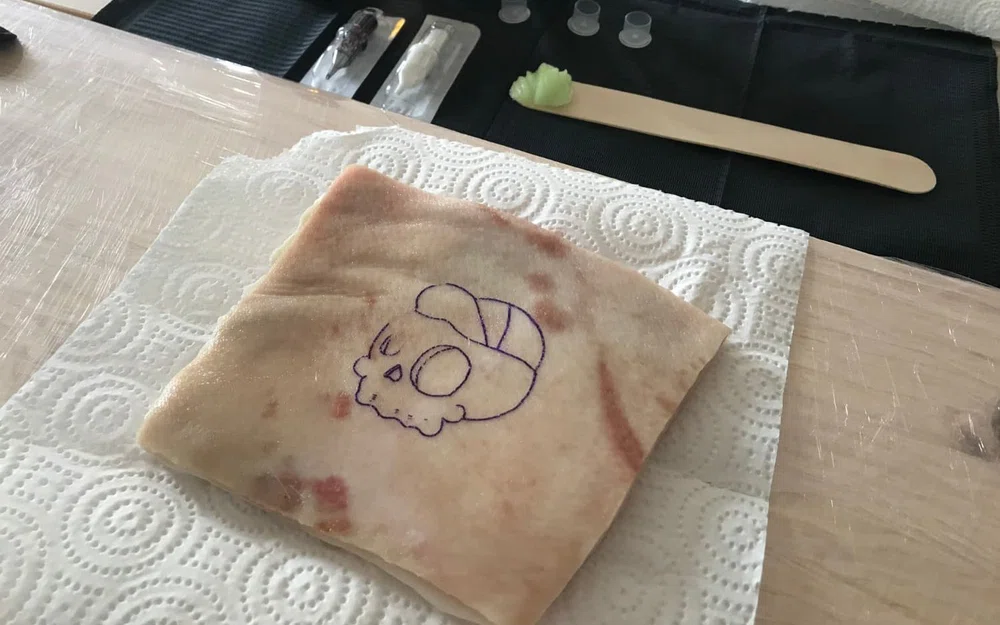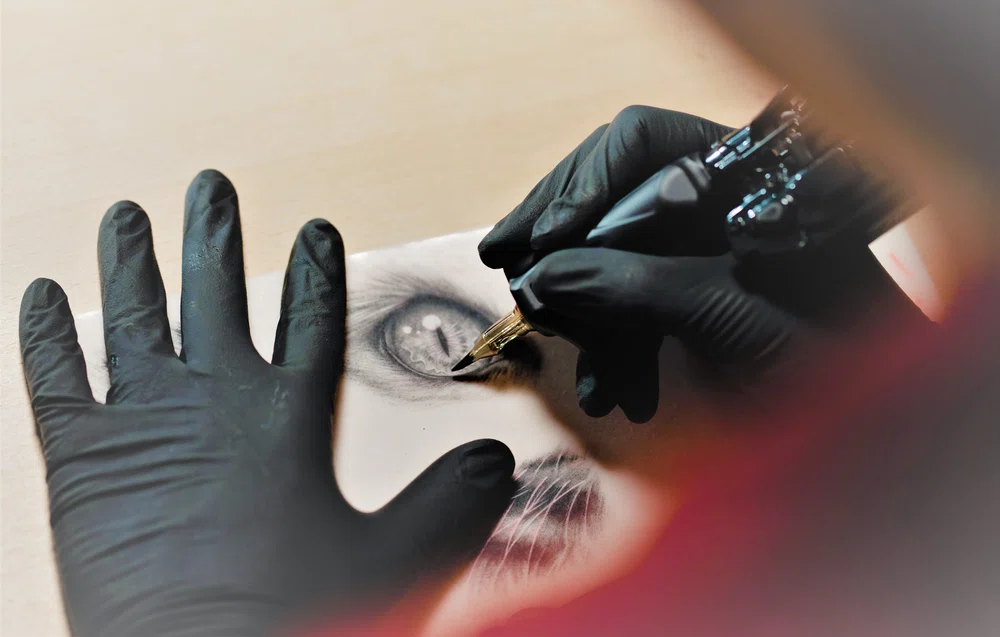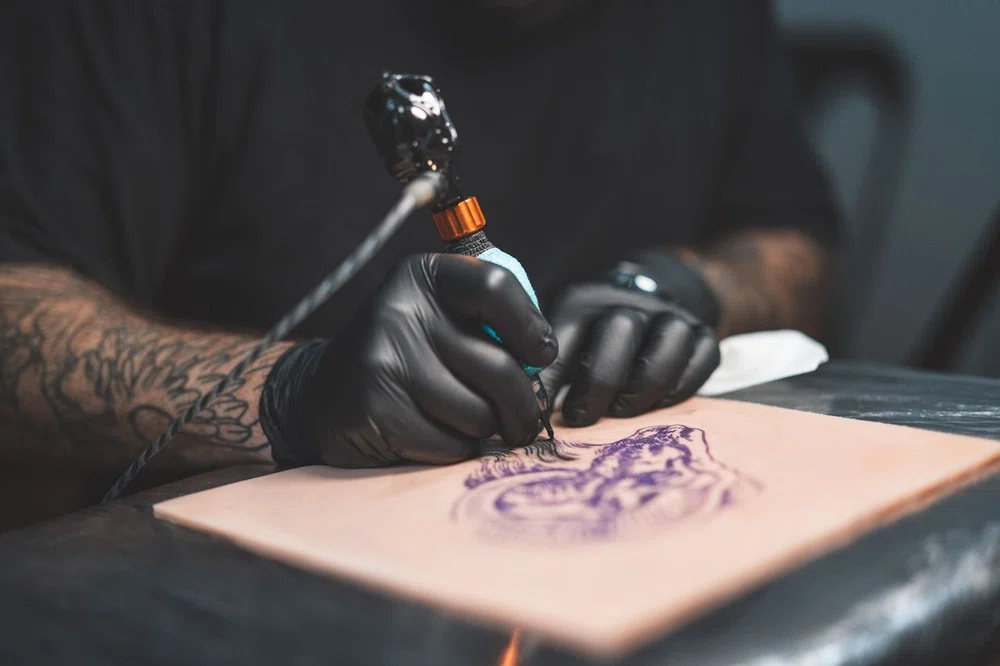Synthetic skins for tattooing
Practice tattooing without making mistakes on your clients
22 January 2024
When you start tattooing, you need to practice, a lot!
Of course, your first tattoos will not be the best ones. That’s why you should practice as much as you can and be willing to learn from your mistakes. Though, the most important thing is to take action with the machines, become friends with the needles, and experiment with the inks.
In order not to cause disasters on the skin of your clients, we’ll give the best options to design and tattoo what you want, but above all, to make mistakes without fear.
What are synthetic skins?
Perhaps you already know that one of the most traditional and well-known ways to start tattooing is by practicing on fruits, such as oranges or melons, since they share some similarities with human skin and receive inks easily.
But did you know that there are fake skins designed specifically for this purpose?
Synthetic skins are becoming increasingly popular and affordable. They are made of synthetic leather in neutral shades that come in different sizes and even shapes.
They exist both in sheet format and even in the form of human limbs. Which is great, since you could practice directly on a surface with a more realistic and faithful shape to the human body.
But most importantly, these skins are not designed to feel like you are tattooing on real human skin.
It is very common to believe that, because it is a material specifically designed for this use, the application of the ink will be the same as when working on human skin.
These skins were designed for you to practice stretching the skin, learn how to make a stencil, and try different techniques and styles of your interest.
Overall, practicing on something other than a person's body brings you closer to the tattooing experience, giving you a better command of the machine, needles and inks. But keep in mind, it will never be like the real deal.
Surfaces suitable for practicing tattooing
Plain synthetic skins and stencils with pre-printed designs:
Synthetic skin not only comes in different sizes, shapes, and thicknesses, but you can also choose between plain or printed designs.
There are even some that can also be attached to the body to get even closer to the activity of tattooing real skin.

Pigskin:
You can get it at any butcher shop. They are not usually sold, so they can give it to you at a very low price or even for free.
As it is an animal material, care before and during the process is essential. You must wash it well, it is recommended to leave it in a bucket with cold water and a bit of chlorine or bleach for 2 hours.

It is also advisable to put it in the freezer, so that it is better preserved when you go to tattoo, since after a few hours it starts to give off odor, which can be very uncomfortable to work with.
In case you want to store them, they can last up to 4 or 6 weeks in the freezer, more than that time is not recommended.
Many use a wooden board covered with plastic film and fix the pigskin on it with rivets. This helps you work more comfortably.
Fruit:
One of the most economical ways is practicing on fruit such as melons, bananas or oranges. And while it doesn't resemble human skin either, it does help you learn how to work on curved and irregularly textured surfaces.
Some recommend using oranges because juice can come out if you poke too deep. Something that can be a bit similar to the skin reaction and its complications during a session.

In the case of practicing with fruit, knowing the limit of the needle is as simple as observing if the fruit "flattens" and breaks.
With this parameter, you can already get an idea of what would happen to human skin. Better to break a fruit than to hurt someone!
What is it like to tattoo on synthetic skin?
- Synthetic skin is harder than real skin, so it can damage the needles more.
This means having to apply a little more pressure, and a bit harder for the inks to get into the skin. There are skins of different thicknesses and they can range between 2 to 8 millimeters.
- For the application of the stencil, it is advisable to let it dry for a while until you can use it.
If you remove it immediately, the ink can be run. Once the paper is removed, some prefer to wait up to 30 minutes before removing all the excess ink.
This way, the stencil gets transferred in a very smooth way. This is ideal because if the ink dries completely, then it becomes almost impossible to remove it. - More than two or three color passes are needed on synthetic skin.
As it is a medium that does not receive the ink so easily, it needs more passes. Whereas on human skin, generally, two passes would be enough, always depending on the case.

Is tattooing on synthetic skin the same as on human skin?
Although it may have been made clear already, it never hurts to warn that... definitely NO. Absolutely nothing is 100% like tattooing on human skin.
But we can still have some common points with the other materials that well-serve as a fairly accurate guide when practicing tattooing.
The key point here is to understand that using different surfaces and textures helps you become familiar with the machines and needles, as well as try out different voltages, while practicing various shading, techniques and styles without the need to harm anyone.
In short, anything that helps you to practice and find yourself in a better condition to move on to human skin is welcome!
What do you have to keep in mind when using synthetic skin?
There are many different types of skins on the market, of different values, of greater and lesser size or thickness, of different colors and shapes, etc. But how to choose the best one?
Well, it depends on the personal preferences of each artist.
Therefore, our recommendation is to investigate more than one option, since trying different materials can help you determine which one best suits your needs.

Don't forget that some skins are harder than others or even more porous, which directly influences the use of inks and needles. Therefore, the best thing you can do to get started is to get whatever is within your reach and begin tattooing.
When tattooing on them, keep in mind that:
- It's not convenient to use the same cleaning products as on human skin.
Keeping synthetic skins clean is much more difficult and with the traditional products that we are used to using, it is not enough, since the remains of ink are not completely erased.
- It's advisable to use Vaseline.
Using Vaseline before and after tattooing is useful to remove any excess of ink.
- It will be more useful to tattoo on curved surfaces than on flat ones.
When practicing with synthetic skin, try not to use it merely as a sheet of paper, so that you gradually get used to the real experience of tattooing on something that is neither uniform nor completely horizontal.
- You don't need to constantly wipe it.
The ink that gets in is minimal compared to human skin. Therefore, it is advisable to clean less frequently to prevent transfers from fading and give the ink time to dry and penetrate the skin.
- Transfer the stencil and wait a few minutes.
When placing the stencil, it is best not to start tattooing right away. In fact, you can help yourself with a hair dryer for the ink to dry, but beware, don’t dry it completely as it may stay there forever. After that, you can clean it with Vaseline and start tattooing.
Can a synthetic skin be reused?
Unfortunately, no. Once a tattoo is done on them, the ink is impossible to remove.
Keep this in mind especially when buying or ordering yours, and consider getting several at once, to have enough surface area to practice on.
And don't forget that you can use the same sheet to try different things, whether it is a design, or a technique or effect that you want to test; that is, you don't need to use one per design.
Fun fact: a book of skins?
Exactly what you’re thinking. The company TBWA \ Lew Lara has teamed up with the magazine Tattoo Artist Magazine to design a book called The Skin Book, as a personal notebook specially designed to practice there.
Instead of sheets of paper, when you open the book, you find sheets of synthetic skin!


Is it useful to practice tattooing on synthetic skin?
Of course it is! Just remember that, although it is the most advantageous method for many reasons, it will never be 100% equal to the experience of tattooing on human skin.
To improve your tattoos on human skin, the best would always be to practice as much as you can on it.
Now, to practice different effects and techniques, to get familiar with the use and weight of the materials you work with, as well as to test yourself on different surfaces, and above all, to get enough confidence before moving on to the real deal... it will always be beneficial to practice on synthetic skin.
Even if you have been tattooing on human skin for a while, you can also seize synthetic skin to continue exploring and evolving as an artist.
You know that in this profession we never stop learning!
And for that, nothing better than having the support and advice of an experienced professional! That's why in ALL our comprehensive tattoo courses we include a large collection of guided practices on synthetic skin: step-by-step hands-on exercises so you can put into practice all the tricks taught by the Masters in detail!